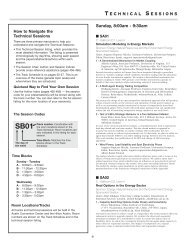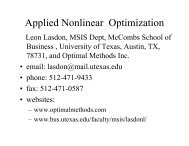Sunday
Sunday
Sunday
You also want an ePaper? Increase the reach of your titles
YUMPU automatically turns print PDFs into web optimized ePapers that Google loves.
SB48<br />
3 - Intersection Signal Optimization using Queue Length Estimation<br />
Yang Cheng, Research Associate, University of Wisconsin-Madison,<br />
2204 Engineering Hall, Madison, WI, 53706, United States of<br />
America, cheng8@wisc.edu, Jeff Ban, Bin Ran<br />
By modern traffic detection technologies, traffic condition data would have higher<br />
resolution in time and space, which is especially valuable for the interrupted<br />
traffic on signalized intersections. The queue length can be estimated more easily<br />
and accurately. Therefore, this study proposes a new signal control optimization<br />
method based on queue information to improve corridor coordination. The<br />
simulation results indicate that this approach has better performance than<br />
traditional control methods.<br />
4 - An Optimal Lane-based Signal Merge Control Model for<br />
Freeway Work Zone Operations<br />
Yue Liu, University of Wisconsin-Milwaukee, P.O. Box 784,<br />
Milwaukee, WI, 53201, United States of America,<br />
liu28@uwm.edu, Jing Mao<br />
This paper presents a dynamic control model for optimizing lane-based signal<br />
merge (LBSM) operations at freeway work zones. The control objective is to<br />
maximize the throughput. GA is employed to solve the model. Results reveal that<br />
the proposed method yields much better performance than traditional merge<br />
strategies under heavy traffic conditions.<br />
■ SB48<br />
48- North 231 A- CC<br />
Integrated Supply Chain Design<br />
Sponsor: Transportation Science & Logistics/ Freight Transportation<br />
& Logistics<br />
Sponsored Session<br />
Chair: Maged Dessouky, Professor, University of Southern California,<br />
University Park Campus, Los Angeles, CA, 90007,<br />
United States of America, maged@usc.edu<br />
1 - Near-optimal Transportation and Fair Cost Allocation in an<br />
Agricultural Supply Chain with Perishable Products<br />
Christine Nguyen, University of Southern California,<br />
Los Angeles, CA, United States of America, nguyen7@usc.edu,<br />
Alejandro Toriello, Maged Dessouky<br />
We consider an agricultural supply chain where several suppliers consolidate<br />
transportation of a perishable product to achieve economies of scale. Using<br />
industry data from California flower growers, we compare a practical greedy onestep<br />
lookahead policy against optimal solutions computed from a dynamic<br />
program, and determine whether transportation costs can be allocated fairly<br />
among the suppliers.<br />
2 - Integrated Supply Chain Network Design: Location,<br />
Transportation, Routing and Inventory Decisions<br />
Mingjun Xia, Arizona State University, 1718 S Jentilly Lane,<br />
APT 204, Tempe, AZ, 85281, United States of America,<br />
Mingjun.Xia@asu.edu, Ronald Askin<br />
We propose a novel model to simultaneously optimize location, allocation,<br />
transportation, inventory and routing decisions in a stochastic multi-product<br />
supply chain system. Each producer provides a unique product. Each retailer has<br />
independent, random demand for multiple products. Consolidation and<br />
distribution facilities may be constructed to reduce shipment costs and increase<br />
the frequency of economical shipments. Heuristics are developed to solve largesize<br />
scale instances of the problem.<br />
3 - Integrated Planning of Supply Chain Layout and Transportation<br />
Infrastructure Rehabilitations<br />
Leila Hajibabai, University of Illinois at Urbana-Champaign, 205 N<br />
Mathews Avenue, Room 3142, Urbana, IL, 61801, United States of<br />
America, leila.hajibabai@gmail.com, Yun Bai, Yanfeng Ouyang<br />
Expansion of supply chains induces considerable freight shipments between<br />
supply/demand points and intermediate facilities, which significantly accelerate<br />
highway pavement deterioration. This paper presents an analytical method to<br />
simultaneously design the supply chain as well as the pavement rehabilitation<br />
plans, which determines the optimum number and location of facilities, shipment<br />
routes, and pavement rehabilitation intensity and frequency.<br />
4 - A Production Function-Based Empirical Analysis of Distribution<br />
Networks<br />
Donald Warsing, Associate Professor, North Carolina State<br />
University, 2346 Nelson Hall, Raleigh, NC, 27695, United States of<br />
America, don_warsing@ncsu.edu, Michael Kay, Christian Rossetti<br />
Using a number of public data sources, we compare distribution networks in the<br />
continental U.S. across several industry sectors. We gather data on, and/or<br />
INFORMS Phoenix – 2012<br />
96<br />
compute from base-level data, a number of independent variables that we use as<br />
inputs to a cost function for each DC in each industry data set. This cost function<br />
serves as an important means of analyzing the variance in the input data and cost<br />
data. We present insights regarding differences in distribution strategies across<br />
industries.<br />
5 - Designing LTL Load Plans to Mitigate Impact of Transit<br />
Time Variability<br />
Yu Zhang, PhD Student, Georgia Institute of Technology,<br />
765 Ferst Dr NW, Atlanta, GA, 30339, United States of America,<br />
zhangyu@gatech.edu, Alan Erera<br />
We develop a method to design robust load plans for LTL carriers in order to<br />
mitigate the cost impacts of transit time variability. Load plan candidates are<br />
generated based on optimizing operations assuming that transit times take<br />
expected values, and then evaluated and refined by Monte Carlo simulation. The<br />
proposed method is applied to a case study which is built based on terminal and<br />
shipment data from a national LTL carrier.<br />
■ SB49<br />
49- North 231 B- CC<br />
Joint Session TSL/SPPSN: Networks and<br />
Emergency Response<br />
Sponsor: Transportation Science & Logistics & Public Programs,<br />
Service and Needs<br />
Sponsored Session<br />
Chair: Halit Uster, Industrial and Systems Engineering, Texas A&M<br />
University, College Station, TX, United States of America,<br />
uster@tamu.edu<br />
1 - A Multi-objective Integrated Approach for Emergency<br />
Response Network Design<br />
Jyotirmoy Dalal, Texas A&M University, 3131 TAMU, College<br />
Station, TX, 77843, United States of America,<br />
jyotirmoy.dalal@gmail.com, Halit Uster<br />
We consider an emergency response network design problem to determine supply<br />
locations and flows required in a large scale evacuation setting. We develop a<br />
multi-objective optimization model with generalized cost structures and<br />
proximity requirements. We present an epsilon-Costraint based approach for<br />
generating the efficient frontier and the computational results, demonstrating the<br />
efficiency of the method.<br />
2 - Network Design for Emergency Response<br />
Jianing Zhi, University of Alabama, 300 Alston Hall, Tuscaloosa,<br />
AL, 35487, United States of America, jzhi@crimson.ua.edu,<br />
Burcu Keskin, Sharif Melouk<br />
We investigate a multi-period ambulance location planning problem to minimize<br />
total cost while maintaining acceptable response times. The network consists of<br />
supply centers, responder and incident locations, and hospitals. We propose two<br />
models: 1) all incidents require service in the period in which they occur, and 2)<br />
incident servicing delays are allowed but with penalty. Through experimentation,<br />
we compare these two models in terms of service quality, response time, and cost.<br />
3 - Resilience in Passenger Transportation Networks<br />
Reza Faturechi, PhD Candidate, University of Maryland, 1173<br />
Glenn L. Martin Hall, College Park, MD, 20742, United States of<br />
America, reza@umd.edu, Elise Miller-Hooks<br />
A bi-level stochastic program with equilibrium constraints is presented for<br />
assessing and optimizing resilience of passenger transportation networks. At the<br />
upper level, preparedness actions are taken to enhance the network or facilitate<br />
response actions, and response actions are taken post-disaster to restore system<br />
capacity. At the lower level, a partial user equilibrium is sought in which<br />
passengers choose their routes to minimize travel time given post-disaster system<br />
performance.<br />
4 - Logistics Planning for Restoration of Network Connectivity<br />
After a Disaster<br />
Sibel Salman, Koc University, Rumeli Feneri Yolu, Sariyer,<br />
Istanbul, 34450, Turkey, ssalman@ku.edu.tr, Ayse Nur Kibar<br />
After a disaster, damaged roads should be repaired/unblocked by a fleet of<br />
machinery initially positioned in a depot to restore highway connectivity. We<br />
define a selective arc routing problem to find the walk of k vehicles with<br />
minimum time to reach connectivity. We provide a flow-based mixed integer<br />
programming model. We consider Istanbul’s highway and determine the number<br />
of machinery and their initial locations under different road damage scenarios for<br />
earthquake preparedness.



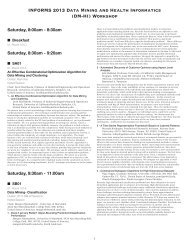
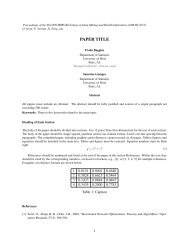
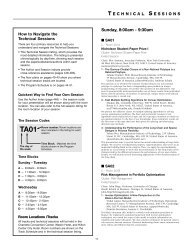
![[PDF] Charlotte Back Matter](https://img.yumpu.com/17933057/1/190x245/pdf-charlotte-back-matter.jpg?quality=85)

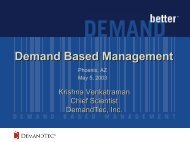
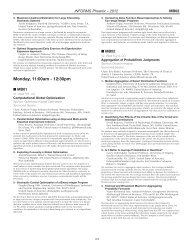
![[PDF] ALIO Back Matter](https://img.yumpu.com/17932960/1/190x245/pdf-alio-back-matter.jpg?quality=85)

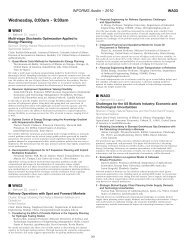
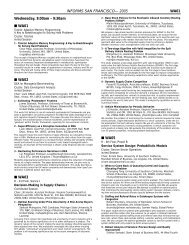
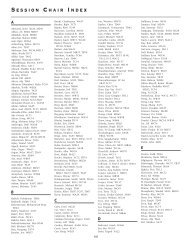
![[PDF] Monday, 8:00am - 9:30am](https://img.yumpu.com/17932954/1/190x245/pdf-monday-800am-930am.jpg?quality=85)
